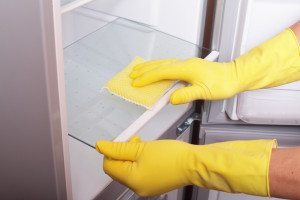New studies show that appliance maintenance and methods of use may be more important for your family’s health than previously believed. Regular kitchen maintenance and sanitation  practices can help you avoid dangerous bacteria and food contamination. Read on for more information about keeping your kitchen sanitary and contaminant-free.
practices can help you avoid dangerous bacteria and food contamination. Read on for more information about keeping your kitchen sanitary and contaminant-free.
What is Food Contamination?
When bacteria spreads between foods, surfaces or appliances, cross-contamination takes place. It’s most likely to happen when raw items touch or drip onto other food or surfaces in your kitchen or on your appliances. It may also occur when people touch raw food with their hands then touch something else. For example, if you store raw meat in your refrigerator and it drips onto the cake below it, bacteria will spread from the meat to the cake. When cutting raw meat on a chopping board, bacteria spreads from the meat to the board and knife. If you use the same tools to then chop something else, the bacteria from the meat will be transferred.
Promptly cleaning up any food spillage is critical, especially inside the refrigerator, freezer, oven or microwave. Follow up with an anti-bacterial spray or wipe to prevent contamination. As important as these safeguards are, however, the most potentially dangerous contamination occurs inside your refrigerator, freezer and oven, when proper temperatures aren’t maintained.
Avoiding the Danger Zone of Food Temperatures
The USDA* defines the danger zone for food contamination as any temperature between 40 and 140 degrees. Salmonella, E. coli and staph bacteria grow exponentially in this range, potentially doubling every 20 minutes. If your refrigerator, freezer or range are not properly calibrated and food is allowed to reach the danger zone, you may be putting your family’s health at risk. Take care with storing and reheating leftovers as well, to ensure they are refrigerated promptly and heated through to an internal temperature of 165 degrees.
You can help prevent food contamination by purchasing thermometers designed for use in your refrigerator, freezer and oven, checking them regularly to ensure proper temperatures are maintained. For your freezer, the USDA recommends a temperature of zero degrees. For the refrigerator, a temperature range of 15 to 35 degrees is ideal. Electronic temperature “guns” are also an excellent way to verify surface temperatures.
Although you can help avert food contamination with these tips and tricks, the most reliable way to ensure that your appliances keep your food safe is to have them inspected, calibrated and maintained regularly by a professional appliance repair service. Complete Appliance Repair of Salt Lake City is dedicated to keeping your appliances well maintained, to keep you and your family safe. Contact them today to schedule a maintenance check for all your appliances.

